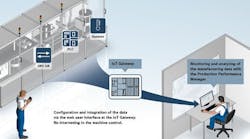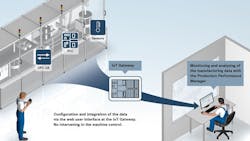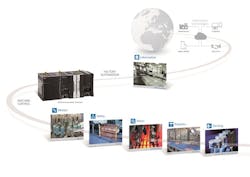When it comes to industrial machine control, there are often 10 or more ways to do it, and they all work, to varying degrees. Some may take a long design path, but it works great. Others may know the shortcuts, but, while missing a few things, they know they are on an efficient design journey.
There are many ways to streamline machine control design. Certain must-have design features will age gracefully, even with some future expansion and change of machine scope.
To start, there is the need for proper documentation. You must have the lines on paper—the design package—before the parts are ordered or the chips and insulation starts flying. "Good documentation is incredibly important to maintaining and upgrading controls," says Gary H. Lucas, director of innovation at Innovative Treatment Products in Owings Mills, Maryland. "I think the cost of large nonvolatile storage is now low enough that documentation could be stored right in the devices. Not only does the design documentation drive the purchasing and manufacturing processed when building the equipment, it’s critical for its operation and future support."
The on-device documentation can certainly streamline access to the design, and so can system architecture and easy, safe communication. "Future control systems need to be Internet-capable,” says Doug Putnam-Pite, director of software development at Owens Design in Fremont, California. "Tool owners will want to be able to connect to their tools from anywhere and see how the tool is performing. Tools conversely need to be able to connect to servers both in-house and in the cloud. All this connectivity needs to be done in a manner that is secure. Too often today, tool developers are either unaware of tool security or just ignore the issue. We will only see more Stuxnet attacks in the future. Tool developers will need to learn how to build secure systems in addition to their existing skills."
The documentation and system architecture will define and connect to a more independently controlled, modular machine that streamlines operation. "I don’t think today’s machine controls can age gracefully any more than a Modicon 984 or Allen-Bradley PLC-2 has aged well two or three decades later," says John Kowal, director, business development, at B&R Industrial Automation. "And it seldom makes sense to put new controls on an old machine, because machine design has become less mechanical and more electrical or mechatronic. Machine design for the next generation of control is becoming less sequential in operation and more flexible with independently controlled shuttles and tracks. By individually controlling products being processed, the term ‘changeover’ will become irrelevant. By modularizing work stations, the term ‘reconfiguration’ will be redefined by replacing one modular operation with another to produce a different product on the same line."
Streamline the communication
Communication is a big part of the discussion when talking about streamlining machine control. Communication buzzwords that should appear in the machine user’s manual include OPC UA, TSN, IO-Link, MQTT and others.
"One of today’s standards that should help to future-proof control concepts is OPC UA TSN," says Kowal at B&R Industrial Automation. "I also can’t believe that more consumer goods companies aren’t publicly demanding ISA-TR88.00.02, aka PackML, for its ability to make OEE, M2M and machine-to-cloud easier to implement. If they don’t support the standard, even though they are using it, OEMs won’t pick up on it."
The communication standards must be in place to get to the needed information; it should simply become part of the design. "More and more, every piece of the automation stream is being asked for more information, from a simple proximity switch all the way up to a high-end machine controller," says Allen Tubbs, product manager, IoT, at Bosch Rexroth, a member of the Control System Integrators Association (CSIA). "Using open standards will prove to be the way of the future. We can see this already with open communication standards like OPC UA. "A proprietary system, controlled by one entity, is not as open for improvement and innovation as an open-body solution. Being open allows for the needs of the industry to be met, rather than the needs of a vendor. This increases the longevity of the standard, ultimately also reducing the need to re-engineer as technology improves (Figure 1)."
Figure 1: Systems designed to communicate using open standards allow for excellent visualization and fast corrective response to irregularities in production.
(Source: Bosch Rexroth)
Distributed intelligence, which the communication connects, is another building block to help to streamline machine control. "Technology such as IO-Link is helping here by making even simple devices, such as a pressure switch, deliver information past a 4-20 mA signal," says Tubbs. "IO-Link is allowing device manufacturers to build intelligence into their products because now they have a cost-efficient way to deliver that data to a central control. Now I can know the manufacturing data of the pressure switch and get diagnostics, like a health index, of the switch itself. This allows a more modular approach to machinery because manufacturers can build valuable features into their products that previously might have needed extensive programming. It isn’t necessary for a programmer to write code to know or detect something about the device. Now the devices are talking themselves."
The smarter a device can be, the more modular it can be, which will streamline design and programming. "For example, if a motor or drive can monitor itself, adjust itself and compensate for real-world conditions on its own, it isn’t necessary to write code or communicate extra data with a central controller," says Tubbs. "This reduces engineering time to configure systems since communication paths and data transfer rates don’t need to be considered for those functions. And, as a bonus, the devices work better, as well, since sensing and reacting are all local to the device."
Software discovery standards
"On the software side, auto-discovery of tags and structures has made a big difference in development time in recent years, along with standardized faceplates and logic," says Kevin McClusky, co-director of sales engineering at Inductive Automation, a member of CSIA. "On the PLC side, standardizing on data structures for common elements creates reusable code. For sensors that are mainly needed for monitoring, newer devices that handle sensor standards such as IO-Link can have OPC UA or MQTT built in, eliminating the need to configure RIO or use fieldbus to bring values back into the visualization software. Efficient, reusable design and centralized configuration provide for flexibility, allowing for a single visual design to apply to multiple different machines, streamlining programming and deployment."
For future-proofing communications, software-to-PLC communication over standard protocols such as OPC UA and MQTT will have significant benefits long-term. "One important feature OEMs will need to consider going into the future is the ability to monitor deployed systems," says McClusky. "More customers are demanding a cloud-based monitoring system, and that demand will grow. As machine builders, you're in the best position to be able to identify issues early or suggest maintenance based on live feedback coming from the machine, and that's a service customers are willing to pay for. Plumbing in the ability for a machine to send data to the cloud today will help future-proof any investments going forward, even if you don't have any cloud services currently in place. If you use the right software, this configuration can also be extremely simple."
Streamlined architecture
[pullquote]A streamlined machine control system design shouldn't be just boxed into the control cabinet; it's distributed throughout the system. "A consistent and field-proven methodology to streamline machine control is the combination of scalable centralized control with distributed I/O and drive technology," says Aurelio Banda, president and CEO, North America, at Beckhoff Automation. "This uncovers immediately apparent benefits such as hardware consolidation and reduced wiring. The approach also reduces programming and installation for all kinds of control hardware. For example, it is possible to do all drive hardware setup and tuning in the centralized controller instead of having to go to each individual drive and handle it locally. Depending on the size of the machine or plant, this can save countless hours of engineering work."
Newer technological advancements such as One Cable Automation further streamline systems. "It is now possible to transmit data and power for all manner of industrial devices on a machine, including motors, drives, HMI hardware, sensors, actuators and much more," says Banda. "A specific example of this is EtherCAT P technology, which acts much the same way as power over Ethernet (PoE) but ramps up the functionality to accommodate industrial-strength power and industrial Ethernet performance."
All talk of machine control and automation must include Industrial-Internet-of-Things connectivity. Omron Sysmac Platform highlights the components needed to build the system from sensor information gathering to cloud communications and back, says Danny Weiss, senior product manager, at Newark Element14. "It takes foresight by the end user to create a machine specification that allows future flexibility. For each automation component, simple or complex, they must feature open connectivity to multiple types and brands of products; they must be field-upgradable in case of improvement opportunities; and they must allow for data to be harvested and leveraged as needed for future optimization (Figure 2)."
Figure 2: A streamlined control platform provides system connections from the sensor to the cloud and back.
(Source Newark Element14 and Omron)
Another way that industrial machine control can be streamlined is by the use of open nontraditional tools and methods of configuration, programming and HMI. "For example, Opto 22’s new Groov Epic system gives users the option of shell access to the Linux OS, so they can run a custom application or develop their control code in the higher-level programming language of their choice including C, C++, Python and others," says Arun K. Sinha, engineer with Opto 22. "Besides providing flexibility for both the machine builder and the user, this approach helps systems age gracefully. Vendor-specific operating systems and programming software can become obsolete as new generations of product are released, which often limits future expansion and change of scope, so this type of flexibility is an advantage."
Also, to help to streamline machine control, OEMs and machine builders should get the automation vendor involved in the design process early. "In today’s world, information is at our fingertips, and engineers can research products and solutions online," says Sinha. "But they often do not contact the automation vendor until very late in the design process. If a vendor is brought in early, they can help the machine builder to take advantage of advanced functionality in ways that may not be apparent to the designer."
Information ownership
Bringing the teams together and using the information is critical for better control. "Today, we are past the stage of individual machine control and are increasingly dependent on good process control over machines that are sourced from different vendors," says Sanket Amberkar, senior vice president of marketing at Falkonry. "To streamline this, the process control cannot be the work of individual vendors, but instead must be owned and adjusted by plant personnel, based on information provided by the machines and intelligence systems. At the machine level, the must-have feature is the ability to incorporate and learn from external data. Recognizing that they are part of a larger process will allow machines to adapt more robustly to changing conditions and requirements."
One of the best examples of expansion and change of scope in machine control can be seen in semiconductor fabs that are keeping up with node changes and design changes, continues Amberkar. "Their approach to predictive analytics and automation combines the knowledge of tool vendors, control design experts and plant/process teams."
Modular checklist
While some may think that every design is custom, a modular approach, even if it includes unused capabilities, reduces the need to reinvent the wheel each time. "From the design level, engineers should use a modular programming methodology and object-based design,” says Chris Como, portfolio manager, motion control business, Rockwell Automation. "You can think of your system as building blocks and design them with a very clear understanding of how they interface with each other. This design approach can eliminate the need to constantly revisit the how of machine control and instead focus on the what and what's next. It also opens the designer up to ways to allow new workflows during design and development."
For example, a machine sales engineer can now have an electronic checklist of the machine that they are selling on a tablet, explains Como. "Whatever they select can then auto-generate the system for a near-perfect creation of the system design, down to the code and hardware selection," he says. "With prebuilt components and a modular format, this is very much possible and will continue to streamline the overall system design."
Increasing compliance to standards will also streamline machine control. "The way data is formatted and exchanged is being driven with compliance to standards," says Como. "This can help to streamline the understanding of how a machine communicates with other sections of the enterprise. Over time, more companies will include analytics within their offerings, and, in many ways, it will become table stakes for selection."
A smart machine recipe
Streamlining industrial machine control for the end user is key, says Simone Gianotti, EcoStruxure industry business development manager at Schneider Electric. "Of course, machine builders also need to optimize their internal processes to build machines more efficiently, but what will inevitably win business on a consistent basis is delivering smart machines that are intuitive to use, simple to monitor and flexible for future enhancements," he says.
According to Gianotti, the must-have features for a truly streamlined industrial machine control system today are:
-
compliance to local safety standards
-
high-quality components to ensure long life and reduced maintenance time
-
flexible design to accommodate future enhancements or re-designs
-
user-friendly interface, alerts, support documentation and maintenance procedures
-
embedded sensing devices and analytics software for preventive maintenance.
"Developing streamlined industrial machine control will be an ever-evolving chase that machine builders should always look to lead in their industry," says Gianotti. "The players that stay ahead of the pack by building the most intuitive and efficient machines will surely remain successful as technology advances."








